 |
Convert MPEG to AVI
|
MPEG to AVI Software converts MPEG to AVI
quickly. Besides AVI, the converter could convert MPEG to common video formats
and portable devices, for example, BlackBerry, AVI, iPod, 3G2, H.264, VOB, 3GP, OGG, DV, OGV, and so on.
The converter is an all-in-one video converter that supports more than 100
video and audio file formats and converts to 40 popular formats. It could convert
VMD to OGV, M2T to 3G2, M1V to Xbox 360, OGX to MPEG, Y4M to FLV, MPG to iPod, OGX to DV, OGX to AVI, and so on.
MPEG to AVI Software supports batch conversion
and is full compatible with 32-bit and 64-bit editions Vista and Windows
7.

What is MPEG?
The Moving Picture Experts Group (MPEG) was formed by the ISO to set standards
for audio and video compression and transmission. Its first meeting was in May
1988 in Ottawa, Canada. As of late 2005, MPEG has grown to include approximately
350 members per meeting from various industries, universities, and research institutions.
MPEG's official designation is ISO/IEC JTC1/SC29 WG11.
The MPEG standards consist of different Parts. Each part covers a certain aspect
of the whole specification. The standards also specify Profiles and Levels. Profiles
are intended to define a set of tools that are available, and Levels define the
range of appropriate values for the properties associated with them. MPEG has
standardized the following compression formats and ancillary standards:
- MPEG-1: The first compression standard for audio and video. It was
basically designed to allow moving pictures and sound to be encoded into the bitrate
of a Compact Disc. To meet the low bit requirement, MPEG-1 downsamples the images,
as well as uses picture rates of only 24-30 Hz, resulting in a moderate quality.
It includes the popular Layer 3 (MP3) audio compression format.
- MPEG-2: Transport, video and audio standards for broadcast-quality
television. MPEG-2 standard was considerably broader in scope and of wider appeal
- supporting interlacing and high definition. MPEG-2 is considered important
because it has been chosen as the compression scheme for over-the-air digital
television ATSC, DVB and ISDB, digital satellite TV services like Dish Network,
digital cable television signals, SVCD, and DVD.
- MPEG-3: Developments in standardizing scalable and multi-resolution
compression which would have become MPEG-3 were ready by the time MPEG-2 was to
be standardized; hence, these were incorporated into MPEG-2 and as a result there
is no MPEG-3 standard. MPEG-3 is not to be confused with MP3, which is MPEG-1
Audio Layer 3.
- MPEG-4: MPEG-4 uses further coding tools with additional complexity
to achieve higher compression factors than MPEG-2. In addition to more efficient
coding of video, MPEG-4 moves closer to computer graphics applications. In more
complex profiles, the MPEG-4 decoder effectively becomes a rendering processor
and the compressed bitstream describes three-dimensional shapes and surface texture.
MPEG-4 also provides Intellectual Property Management and Protection (IPMP) which
provides the facility to use proprietary technologies to manage and protect content
like digital rights management. Several new higher-efficiency video standards
(newer than MPEG-2 Video) are included (an alternative to MPEG-2 Video), notably:
- MPEG-4 Part 2 (or Simple and Advanced Simple Profile) and
- MPEG-4 AVC (or MPEG-4 Part 10 or H.264). MPEG-4 AVC may be used on
HD DVD and Blu-ray discs, along with VC-1 and MPEG-2.
In addition, the following standards, while not sequential advances to the
video encoding standard as with MPEG-1 through MPEG-4, are referred to by similar
notation:
- MPEG-7: A multimedia content description standard.
- MPEG-21: MPEG describes this standard as a multimedia framework.
Moreover, relatively more recently than other standards above, MPEG has started
following international standards; each of the standards holds multiple MPEG technologies
for a way of application. For example, MPEG-A includes a number of technologies
on multimedia application format.
- MPEG-A: Multimedia application format.
- MPEG-B: MPEG systems technologies.
- MPEG-C: MPEG video technologies.
- MPEG-D: MPEG audio technologies.
- MPEG-E: Multimedia Middleware.
What is AVI?
Audio Video Interleave, known by its acronym AVI, is a multimedia container format
introduced by Microsoft in November 1992 as part of its Video for Windows technology.
AVI files can contain both audio and video data in a file container that allows
synchronous audio-with-video playback. Like the DVD video format, AVI files support
multiple streaming audio and video, although these features are seldom used. Most
AVI files also use the file format extensions developed by the Matrox OpenDML
group in February 1996. These files are supported by Microsoft, and are unofficially
called "AVI 2.0".
There is slight overhead when used with popular MPEG-4 codecs (Xvid and DivX,
for example), increasing file size more than necessary. The AVI container has
no native support for modern MPEG-4 features like B-Frames. Hacks are sometimes
used to enable modern MPEG-4 features and subtitles, however, this is the source
of playback incompatibilities.
Step-by-Step Instructions to Converting MPEG to AVI
- Free Download
MPEG to AVI Software
- Install the software by step-by-step instructions
- Launch MPEG to AVI Software
- Choose MPEG files

Click "Add Files" to choose MPEG files and add them to
conversion list.
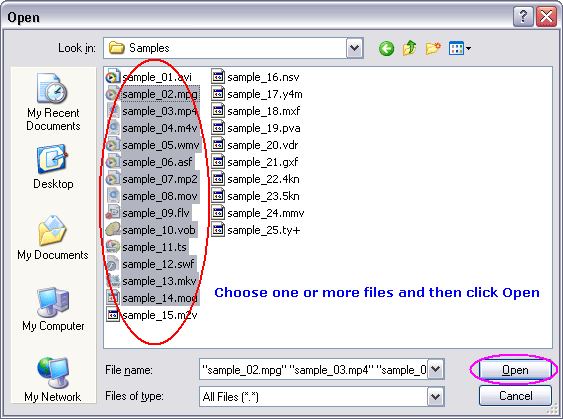
Choose one or more MPEG files you want to convert and then click Open.
- Choose "to AVI"
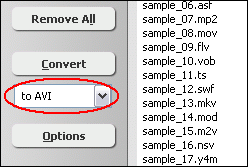
[Optional] If you want to change AVI encoding parameters, for example, vodec
codec, bit rate, frame rate, video size, and aspect ratio, please click "Options".
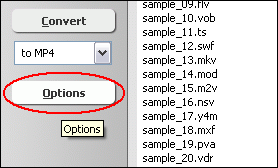
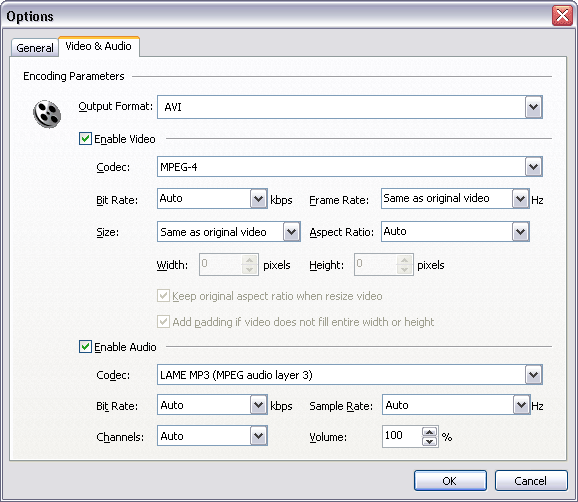
[Optional] Switch to tab "Video Options" and then set encoding
parameters.
- Convert MPEG to AVI

Click "Convert" to convert MPEG files to AVI.
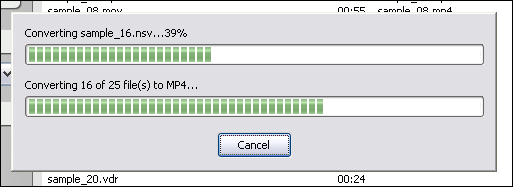
The software is converting MPEG to AVI.
- Play & Browse
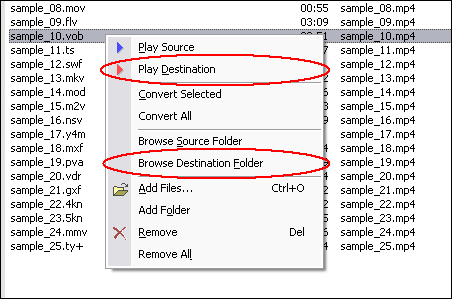
When conversion completes, you can right-click converted item and choose "Play
Destination" to play the outputted file; or choose "Browse Destination
Folder" to open Windows Explorer to browse the outputted file.
- Done
Top
MPEG to AVI Software is 100% clean and safe to install.
It's certified by major download sites.

Convert MPEG to AVI Related Topics:
|










